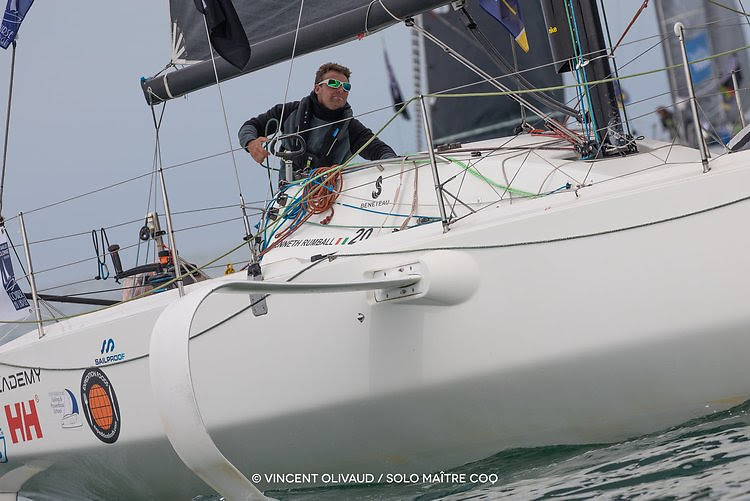Here I am on the ferry back to Ireland, absolutely shattered after another month of intense offshore sailing in France at the highest level, there is a lot to reflect on as always and more importantly build upon!
If you prefer a video, full video log here!
We headed out for some last-minute sail testing and short course practise ahead of the Solo Maitre Coq, the first solo offshore event of the year for the Figaro Class at the beginning of the month. The time flew by and before we knew it after some rig tweaks and changes of battens in our jib, we were off up to Les Sables d’Olonne to line up for the first time this year against the rest of the fleet.
We had glorious weather for the few days of boat, sailor and meteo preparation for this event. I was very lucky to have Paddy Hutchings an experienced preparateur and future Figaro rockstar join me to make sure the boat was 110% ready for the races. Paddy was busy checking lines, re-splicing and swimming in the boat daily to make sure the underside of the hull was as clean as possible for racing! Timothy Long who had done some sailing with me as part of the Academy was also on hand to help out as he was learning all about the preparation that goes into these boats before we head to sea for a race!
 Kenny Rumball in the Solo Maitre Coq Regatta Photo: Vincent Olivaud
Kenny Rumball in the Solo Maitre Coq Regatta Photo: Vincent Olivaud
Our racecourse was largely unchanged with the notable exception that we would be omitting the Birvedeau lighthouse from the course as there would be military firing exercises in that area while we would be racing. It would mean rounding the Island of Belle Ile would be the most northerly part of the course! As for the weather, it was looking pretty straightforward, upwind there, downwind home, a windward-leeward just 330 miles long!
The race started off as predicted by the weather with a light 10-13 knots of wind from the north, the race committee gave us a short beat to ensure the fleet got away evenly before we headed off downwind to Ile d’Re. The wind was coming from the shore and initially, those the dared go as close to the exclusion zone on the shore as possible were the early boats to gain, of which IRL 20, Kenny was…
Not more than three hours into the race, we had our first shutdown and weather transition with the new wind coming from the North West. This saw a small reshuffle of the pack but nothing to worry about. This new wind was to build for the rest of the day and shift back to the North East overnight, which it did exactly! Coming around Ile d’Re we were quickly sailing upwind in demanding conditions short tacking as close to the coast as possible, moving the 90kgs of stackable weight on every tack! Tiring work but working hard here separates the fleet!
 Kenny Rumball was as a high as 11th a one point Photo: Vincent Olivaud
Kenny Rumball was as a high as 11th a one point Photo: Vincent Olivaud
Eventually, the fleet settled onto starboard tack which would take the fleet past Ile d’Yeu, leaving it to port and all the way up to Belle Ile. From here it was a drag race of identical boats! Sail selection, setup and time spent driving would be the determining factors on speed and ultimately position! It was the first real test of speed for the fleet in 2022!
By early morning the time spent sailing the boat hard through the night was well spent with some place gains overnight and approaching Belle Ile in a good position! The wind had not really changed with around 20-24kts all the time! We were expecting it to have died to around 15 kts for the downwind kite sail back towards Les Sables! But more wind means more speed, our biggest spinnakers up and we were off heading downwind at speed to the Rochebonne plateau. 25kts of wind, big sea state saw consistent boat speeds in the high teens all the way south…. Lots more driving required meant no time for rest or food, this was turning out to be a tough race.
By the Rochbonne Plateau, we had a big sea state and winds into 30kts, taking the big spinnaker down solo was demanding especially when there is only one of them on board and we knew it was needed later on in the race! Damaging it was not an option…
If you thought there was time for rest, the intensity continued with gennakers unfurled blast reaching back in the direction of Les Sables at a consistent 15 knots or so. At this stage, I was sitting comfortably in 11th position knowing all that was a left was a 60nm loop from Les Salbes out to a weather buoy 30 miles to the South West and then back again. How hard could it be?
As is typical in the Figaro class… Very! Approaching the weather buoy, the wind died and died and we rounded it in 0kts. 30 Miles back to Les Sables, tired, hungry and being honest, a bit emotional!
Given that in the fleet we are not allowed to carry mobile phones or have any assistance from the outside world our weather information was now 48hours+ old so it was very hard to determine where to position oneself on the beat home.
Ultimately the left-hand side of the course paid with the top back having a pretty big reshuffle as well as the rest of the fleet. Frustratingly, I dropped 9 places eventually crossing the finish line in 20th position. However, I was very content with my overall performance taking into account decision making, speed and sail selection!
We now had A FULL DAY off to recover before two coastal sailing days on Saturday and Sunday. It was a joy for me as my parents came out to visit and support the last two days of the event. Saturday was very very light winds, no more than 5kts where the race officer gave us Bannane courses which are windward-leewards. Hugely unstable light and variable winds saw one messy race completed where I was consistent finishing 19th, leaving me 18ht overall in the standings going into the last day.
For the last race, we were to have a coastal race of 30 miles with a short upwind, equally short downwind before a beat up the coast past Les Sables and then back. A good start saw me around the first windward in the mix of the lead pack and I held this on the next downwind leg. However on the 11 mile upwind I started to realise something was wrong as my speed was not as good as on the long offshore race. Post-race discussion and it would be evident I had set my mast up wrongly with too much tension in the D1 shrouds. I still managed to keep the boat moving and finished this race in 20 position, leaving me 20th overall in the event.
Given this was my first solo race in two years with a considerable improvement in performance and finishing position over my last solo race, I have walked away from the event very content.
It was now time to rest, I was very fortunate that Paddy along with some members of the Malizia IMOCA team took the boat north for me to Port La Foret where it lives when not sailing. It has been a very intense few months with the boat being lifted out of the water for the first time since January!
There is now some time off before we’re off to the UK this weekend for the RORC Cervantes race this weekend with some fellow Irish sailors. It's busy busy and important to find some rest in-between these races if only for a day or two!
Lots more to come so keep tuned for next month’s exploits.


























































